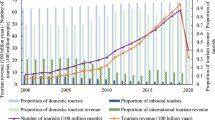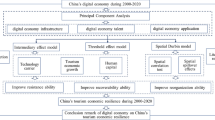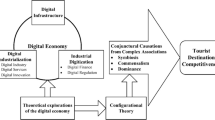Abstract
Despite widespread concerns about the effect of the digital economy on productivity, few studies have examined the relationship between the digital economy and tourism demand. Based on 285 China’s prefectural-level city statistical data and big data from 2011 to 2019, a comprehensive index of the digital economy is developed and a spatial econometric model is employed to investigate such relationship. The result shows that the growth of the digital economy has positive spatial spillover effects on tourism demand, contributing to extending the impact of the digital economy on tourism demand from the spatial perspective and providing insights for policymakers on regional cooperation in the digitalisation context.
You have full access to this open access chapter, Download conference paper PDF
Similar content being viewed by others
Keywords
1 Introduction
The growing importance of tourism to the economic system has caused obvious interest in identifying the fundamental factors that influence tourism demand. As different theories have been introduced, the significance of variables has been examined. Nevertheless, little light has been shed on the effect of the digital economy despite its potential to generate more than $300 billion in value for the tourism industry. Tourism may benefit more than any other industry from the digital economy due to the extremely high information asymmetry and transaction costs that have hindered the growth of tourism demand [2]. Recent empirical research has indicated that improved local digital capabilities have contributed to inbound tourism [1]. However, past studies have neglected externalities of the digital economy and its spatial effects [14]. The digital economy can reduce transaction costs and facilitate interaction between tourists and destinations, resulting in its impact not only being limited to the local area [9]. This research, therefore, examines the spatial spillover effects of the digital economy on tourism demand utilising panel data from China’s prefectural-level cities between 2011 and 2019. Considering multiple data sources, a comprehensive index is constructed to measure the development of the digital economy at the city level. The spatial Durbin model is used to capture both the direct and spatial spillover (indirect) effects of the digital economy on tourism demand, thus increasing the understanding of the spatio-temporal relationship between the digital economy and tourism demand and enabling policymakers to adopt effective destination management strategies in the digitalisation context.
2 Literature Review
The digital economy refers to a new economic form that creates value via digital technology and infrastructure, digital industry, and engagement in utilising and creating digital services [6]. Due to the externality of the digital economy, it can have effects on both local and neighbouring regions as the digital economy effectively connects market participants across regions, hence generating spatial spillover effects [12]. On the one hand, the digital economy can have negative spatial spillover effects as it can reduce the transmission costs of explicit knowledge, resulting in an increasing demand for tacit knowledge and offline services [3]. On the other hand, the digital economy can have positive spatial spillover effects as it promotes user connectedness and becomes a feasible substitute for physical space [16]. In this case, the digital economy can better facilitate the matching of supply and demand across spatial regions [11].
According to existing studies, tourism demand is impacted by factors such as price and income [8], but spatial and temporal constraints experienced by tourists are ignored. As a result of the widespread adoption of digital technology, the digital economy has completely enhanced the interaction between tourists and destinations [15]. At the micro and tourist levels, previous research has highlighted the role of the digital economy in easing information asymmetry and promoting transactions [7]. As for destinations, providers’ increasing reliance on ICT to build a “virtual link” with visitors can enable them to elevate the accuracy of tourism demand forecasting and rapidly supply products that meet tourists’ needs, thus enhancing the attractiveness of destinations [5]. Moreover, the digital economy has blurred the boundaries between tourists and destinations; tourists become co-creators in the design of services, hence decreasing the cost of personalised services and enriching the tourism experience [4].
However, previous micro-level research employing qualitative analysis and questionnaires have argued that different aspects of the digital economy help reduce tourism uncertainty, hence influencing tourists’ behavioral intentions. Direct evidence of the digital economy’s effect on actual tourism demand at the macro level is still lacking. Recent research has examined the effect of the digital economy on local tourism demand at the national level [1]. Yet, few studies investigated the impact of the digital economy on tourism demand at a regional level. Given time and distance limits, inter-regional tourism is likely to be the most popular option for tourists, especially for a country with a wide territory like China, where inter-regional tourists accounted for 98% of total tourists in 2019 [10]. Moreover, due to the externalities of the digital economy, it becomes essential to examine the spatial effects of the digital economy on tourism demand. However, it is still unclear whether the digital economy has significant spillover effects on tourism demand across space and time and this study aims to fill this knowledge gap.
3 Methodology and Data
Considering the existence of spatial spillover effects, this research explores the relationship between the digital economy and tourism demand using the spatial Durbin model (SDM):
\({Tourism}_{it}\) is the tourism demand; ρ is the coefficient of the spatial lag of tourism demand; \({\omega }_{ij}\) is the spatial matrix; \({Dig}_{it}\) is the level of the digital economy; \({X}_{it}\) is other control variables that may affect tourism demand; \({\beta }_{i}\) is the estimated coefficient of the explanatory variable; \({\theta }_{i}\) is the estimated coefficient of the corresponding spatial lag; \({\omega }_{ij}\) is the spatial weight matrix that represents the spatial relationship between different cities – queen contiguity-based and distance-based spatial weights matrices.
The independent variable is the digital economy. It is difficult to accurately capture the digital economy using a single indicator as it is a complex system. In this paper, we evaluate the level of the digital economy by developing a comprehensive index. With the availability of big data, we not only incorporate key indicators from previous research [1, 14, 16] but also introduce new indicators. The comprehensive index system includes three dimensions. The indicators and corresponding data sources are presented in Table 1. Indicators of the digital economy Considering these indicators are highly correlated, the principal component analysis (PCA) method is employed to transform multiple indicators into a comprehensive index by dimension reduction. Bartlett’s sphericity and KMO tests indicated that the above indicators are statistically appropriate for PCA. This study identified three components based on the cumulative variance contribution of 80% and generated the index using the factor scores and weights.
The control variables include: house prices and GDP per capita are added to illustrate the effect of the local price level and income on tourism demand; road density and the high-speed rail reflect the level of local traffic condition; the proportion of tertiary industry to GDP as a measurement of localisation economics; and 5A top-grade tourist attractions authorised by the Ministry of Culture and Tourism of China. Data of these variables was gathered from China City Statistical Yearbook, CEIC database, China Real Estate Statistical Yearbook, and China’s HSR network map.
4 Results
Various tests are run to determine which type of econometric model is appropriate for this study. The (Robust) LM Spatial error and Spatial lag statistics under various matrices were statistically significant at the 1% level. Both the Wald and Lratio tests were also significant at the 1% level, confirming that the spatial Durbin model was suitable for this study. Model 1 shows the results of the fixed effect model (Table 2). The coefficient of the digital economy is 0.5803 and statistically significant at the 1% level, showing that the digital economy has a significant positive effect on the rise of local tourism demand. The findings of the spatial Durbin model based on the queen contiguity-based spatial matrix (Model 2) and geographic distance matrix (Model 3) show that the digital economy has a positive spatial spillover effect that can increase both local and neighbouring tourism demand. This implies that the digital economy can contribution to inter-regional tourism. In addition, the coefficient of the spatial lag of tourism demand (Spatial rho) is significantly positive at the 1% level, indicating the existence of the spatial spillover effect of tourism demand. This implies that an increase in tourism demand in one city leads to an increase in demand in neighbouring cities. Thus, findings infer the importance of spatial effects of both tourism demand and the digital economy. Spatial spillover effects can also be observed in the control variables.
5 Conclusion
According to the results of the spatial panel Durbin model, the digital economy has the positive spatial spillover effects on tourism demand. The result remains robust under different matrices, demonstrating that the digital economy can strengthen the interaction of tourism between cities and significantly contribute to inter-regional tourism. To the best of the authors’ knowledge, this study is the first to analyse the spatial spillover effects of the digital economy on tourism demand. Given the significance of the spatial spillover effects, tourism researchers are challenged to examine effects of the digital economy from the inter-regional perspective; otherwise, it could lead to estimation bias. Capturing and understanding spatial spillover effects of the digital economy on tourism demand can enable industry practitioners and destination management organisations to depend on digital technology to exchange market information, jointly build a cross-regional tourism collaboration system and achieve the connectivity benefits of the digital economy.
References
Adeola, O., Evans, O.: ICT, infrastructure, and tourism development in Africa. Tour. Econ. 26(1), 97–114 (2020)
Chung, M., Herzberger, A., Frank, K., Liu, J.: International tourism dynamics in a globalized world: a social network analysis approach. J. Travel. Res. 59(3), 387–403 (2020)
Craig, S.G., Hoang, E.C., Kohlhase, J.E.: Does closeness in virtual space complement urban space? Socio-Econ. Plan Sci. 58, 22–29 (2017)
Dijkmans, C., Kerkhof, P., Beukeboom, C.J.: A stage to engage: social media use and corporate reputation. Tour. Manag. 47, 58–67 (2015)
Divisekera, S., Nguyen, V.K.: Drivers of innovation in tourism: an econometric study. Tour Econ 24(8), 998–1014 (2018)
Goldfarb, A., Tucker, C.: Digital economics. J. Econ. Lit. 57(1), 3–43 (2019)
Law, R., Leung, D., Chan, I.C.C.: Progression and development of information and communication technology research in hospitality and tourism: a state-of-the-art review. Int. J. Contemp. Hosp. Manag. 32(2), 511–534 (2019)
Li, H., Song, H., Li, L.: A Dynamic panel data analysis of climate and tourism demand. J. Travel. Res. 56(2), 158–171 (2016)
Lorente-Bayona, L.V., Gras-Gil, E., Moreno-Enguix, M.D.R.: Internet penetration and international travel and tourism expenditure: the role of foreign exchange control. Tour Econ, 135481662110278 (2021)
Cheng, S.: Tourism industry reports steady growth in 2019. China Daily http://www.chinadaily.com.cn/a/202003/10/WS5e678050a31012821727defe.html. 10 March 2020
Ramaswamy, V., Ozcan, K.: Offerings as Digitalized interactive platforms: a conceptual framework and implications. J. Mark. 82(4), 19–31 (2018)
Sorescu, A., Schreier, M.: Innovation in the digital economy: a broader view of its scope, antecedents, and consequences. J. Acad. Mark. Sci. 49(4), 627–631 (2021)
Tranos, E., Nijkamp, P.: The death of distance revisited: Cyber-place, physical and relational proximities. J. Reg. Sci. 53(5), 855–873 (2013)
Wang, Y., Sun, B., Wu, S., Li, W., Zhang, T.: Can the internet reshape the national city size distribution? Cross-country evidence. Pap. Reg. Sci. 100(5), 1254–1272 (2021)
Xiang, Z., Gretzel, U.: Role of social media in online travel information search. Tour. Manag. 31(2), 179–188 (2010)
Zhang, W., Liu, X., Wang, D., Zhou, J.: Digital economy and carbon emission performance: evidence at China’s city level. Energy Policy 165, 112927 (2022)
Author information
Authors and Affiliations
Corresponding author
Editor information
Editors and Affiliations
Rights and permissions
Open Access This chapter is licensed under the terms of the Creative Commons Attribution 4.0 International License (http://creativecommons.org/licenses/by/4.0/), which permits use, sharing, adaptation, distribution and reproduction in any medium or format, as long as you give appropriate credit to the original author(s) and the source, provide a link to the Creative Commons license and indicate if changes were made.
The images or other third party material in this chapter are included in the chapter's Creative Commons license, unless indicated otherwise in a credit line to the material. If material is not included in the chapter's Creative Commons license and your intended use is not permitted by statutory regulation or exceeds the permitted use, you will need to obtain permission directly from the copyright holder.
Copyright information
© 2023 The Author(s)
About this paper
Cite this paper
Liu, Z., Kim, Y.R. (2023). Spatial Spillover Effects of the Digital Economy on Tourism Demand: Evidence from China. In: Ferrer-Rosell, B., Massimo, D., Berezina, K. (eds) Information and Communication Technologies in Tourism 2023. ENTER 2023. Springer Proceedings in Business and Economics. Springer, Cham. https://doi.org/10.1007/978-3-031-25752-0_9
Download citation
DOI: https://doi.org/10.1007/978-3-031-25752-0_9
Published:
Publisher Name: Springer, Cham
Print ISBN: 978-3-031-25751-3
Online ISBN: 978-3-031-25752-0
eBook Packages: Business and ManagementBusiness and Management (R0)




